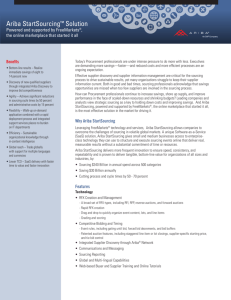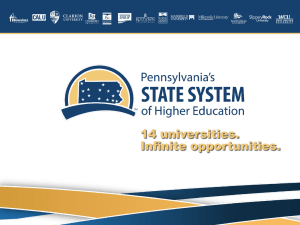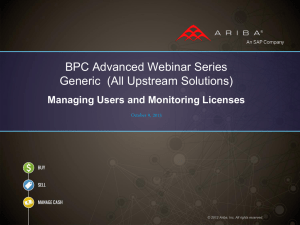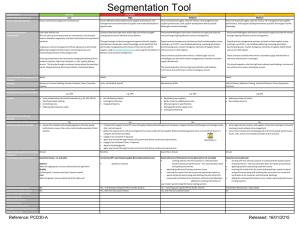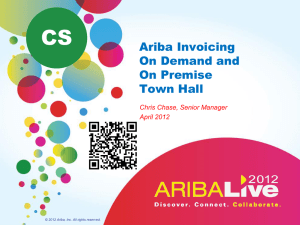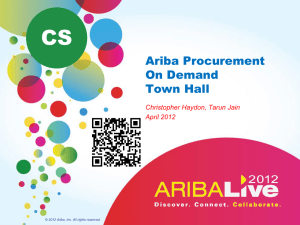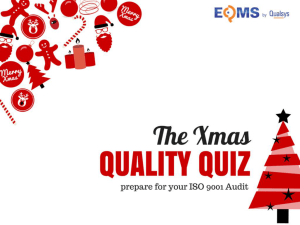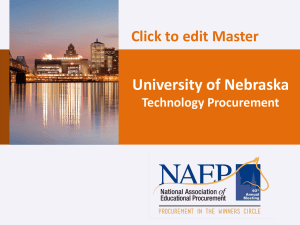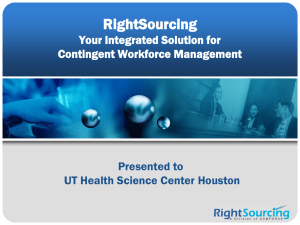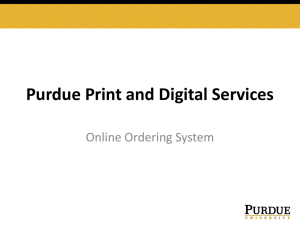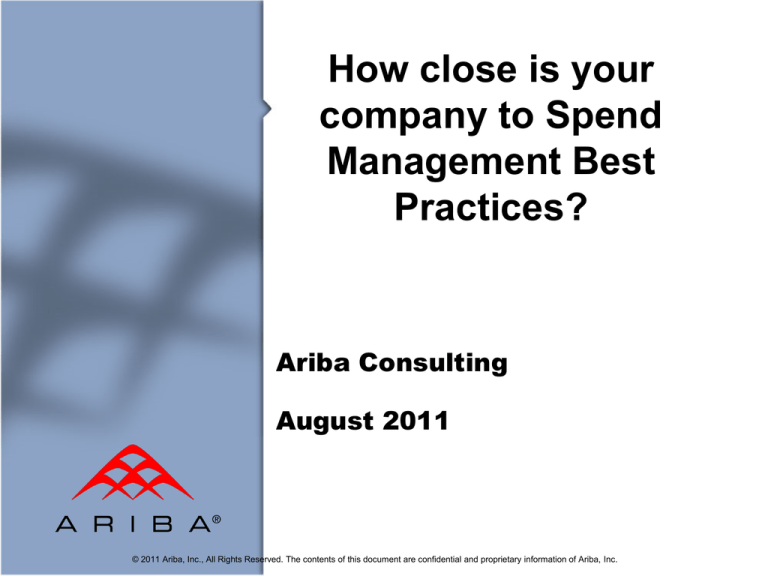
How close is your
company to Spend
Management Best
Practices?
Ariba Consulting
August 2011
© 2011 Ariba, Inc., All Rights Reserved. The contents of this document are confidential and proprietary information of Ariba, Inc.
How close is your company to P2P Best Practices?
Traditional/Base line
Advanced
Best In Class
P2P processes for
spending and payment
No formal written P2P
processes.
Written P2P processes, but often not
followed by users or groups.
Electronic P2P policies are followed by all
groups and regions.
End user training
No formal training or only
done occasional.
Written manuals used to train new users.
Written, class room, and/or WBT (Web
Based Training)
Pre-spending approval
(PO/Contract)
Users can often order what
they want without a
PO/Contract.
Have PO/Contract process, but users
often do not use them (often claiming
“need now”” or “one time buy” as reason
for no PO/Contract).
All spending is pre-approved via
PO/Contract or uses an approved
exception process.
Approval workflow
Purchasing approvals are
manual.
Purchasing approvals are static electronic,
but are often not followed or Approvers do
not approve quickly.
Purchasing approvals are dynamic
electronic, with automated escalations to
support quick approvals.
PO/Contract execution
(signatures) and
transmission method
Original documents are
manually signed (wet
signature) and mailed.
Original or faxed documents are
manually signed and mailed, faxed, or
emailed.
Documents are electronically signed and
transmitted via EDI or Internet.
Invoice creation and
transmission method
Supplier creates invoice and
sends via mail.
Company creates invoice created from
PO/Contract
Supplier creates invoice from PO/Contract
and sends via EDI or Internet.
Invoices approvals and
supplier updates
Invoices are manually
matched (either 2 or 3 way
match). Supplier frequently
calls A/P for updates.
Some invoices are electronically auto
matched, but many are manually match.
Supplier often calls A/P
All invoices are auto matched. Minimal
creation of “after the fact” invoices.
Frequent use of Invoices created directly
from Contracts. Supplier gets updates
electronically, so seldom calls A/P.
Early pay discounts
Never take early pay payment
discounts (often since
approvals are too slow)
Take some early pay discounts, but
manual process limits use.
Electronic processes for approval and
discounting allows dynamic use of early
pay discounts
Payments
Payments by check.
Payment by check and purchasing
cards (Pcards).
Heavy use of electronic payments
(Pcards, Electronic Funds Transfer [EFT]).
Reporting
Reports are missing key P2P
information and are not
considered useful.
Reports have more information, but
users still need outside help to run key
reports. Few exception reports.
Automated reporting that highlights
exceptions. Reports can be run and
modified by users without outside help.
© 2011 Ariba, Inc., All Rights Reserved. The contents of this document are confidential and proprietary information of Ariba, Inc..
How close is your company to Contracts Best Practices?
Traditional/Base line
Advanced
Best In Class
No formal written contracts
processes, thus often use “third
party paper” instead of your own
contract Word file.
Have written contracts processes, but often
not followed by users or groups, and often
still use “third party paper”.
Have electronic contracts policies (with
checklist/tasks) that are followed by all groups
and regions. But still may have to use “third
party paper”.
End user training
No formal training or only done
occasionally.
Written documents (like Quick Reference
Guides) to train new users.
Written, class room, and/or WBT (Web Based
Training) are used for new users.
Types of contracts
electronically supported
No electronic contract system for
any type of contract (Buy side or
Sell side or Misc (like NDA)
Electronic contract system for at least one
type of contract.
Electronic contract system for all types of
contracts.
Approval workflow
Contract approvals are manually
done by paper signatures.
Contract approvals are static electronic, but
are often not followed or Approvers do not
approve quickly.
Contract approvals are dynamic electronic,
with clause level approvals, with automated
escalations if approvals are delayed..
Contract execution
(signatures) and
transmission method
Original documents are manually
signed (wet signature) and
mailed.
Original or faxed documents are manually
signed and mailed, faxed, or emailed.
Documents are electronically signed and
electronically transmitted.
Contract template (Word
file) used to create
contracts and for the
amendment process
Separate Word file used for
different contract types, with
manual Word file update of each
different Word file.
Correct Word files is electronically selected
for use with different contract types, with
manual Word file update of each different
Word file.
Correct Word file is electronically selected for
the correct contact type. Contract template
Word files are electronically mass updated for
common changes (via clause library)
Invoices for
goods/services covered
by contracts
Invoices are manually created
and mailed to your company.
Some invoices are created electronically
from the contract to reduce invoice errors.
Many invoices are created from contract by
suppliers/customers and electronically sent for
auto matching to contract before payment.
How is legal team
involved for contract
changes/edits
Legal team called for all changes
for all contacts (no pre-approved
alternate clauses used).
Legal team advice is in contract Word file
(must remove before executing) or in
associated separate document. Legal team
often called for routine changes. Use
common clauses in Word files.
Legal team advice is accessible from the
contract Word file but not part of the Word file.
Standard pre-approved alternate clauses
available so legal team only called for unusual
edits or situations.
Integration
Contracts software is stand alone.
Share contract base data (suppliers, users,
categories, etc) with other software system.
Contracts software integrated to other software
for base data, sourcing, procurement,
compliance, payment, etc.
Contract storage,
searching, reminders and
metrics.
Paper contracts stored in file
cabinets, and must be manually
searched. No electronic
reminders nor contract metrics.
Electronic storage, with electronic searching
of header data and electronic reminders of
upcoming contract expiration. Some
contract metrics.
Electronic storage, with electronic searching of
header data and document free text searching,
with electronic reminders of multiple events
(such as expiring certifications or contract
renewals). Use contract metrics.
Contract processes
(including editing and
amendments)
© 2011 Ariba, Inc., All Rights Reserved. The contents of this document are confidential and proprietary information of Ariba, Inc..
How close is your company to Sourcing Best Practices?
Traditional/Baseline
Advanced
Best In Class
Sourcing Process
No documented sourcing process
in place.
A sourcing process exists 65% of time,
however it is only partially in use, partially
automated and has limited visibility.
Fully documented sourcing process has been
agreed upon business-wide and is being used
across the organization 100% of the time.
Pipeline Planning/Knowledge
Management/Spend Under
Management
•Adhoc/reactive sourcing, no
strategic targets or goals
•Less than 40% of spend under
managed structure
•A list of projects exist, but without a
measured goals or strategic plan for
execution
•Over 40% spend under management by
sourcing teams
•Pipeline is established with targets, goals,
scheduled progress reviews and tracking via ESourcing tool
•About 75% of spend under management by
sourcing teams
Supplier Selection/
Performance
No certification/ framework/
structured research
A process, however with limited qualification
criteria, exists but is not always applied
A formal identification/certification process and
performance metrics exist, with minimum
requirements for various levels of spend
Data Collection/Quality
Consolidated spend data is not
available.
•Data can be extracted at the
Invoice/Purchase Order level with limited
descriptions of goods and services.
•Historic documentation exists but is not
centrally organized
•Consolidated data can be extracted including
Purchase Orders, requisitions, invoices, contracts,
sourcing projects, supplier performance metrics or
scorecards etc.
•Documents and Project Data are kept in one tool
available to teams for reference
Historical Spend/
Savings Goals
Limited/no data available, no
defined metrics
Historical/baseline spend is established.
Some documented definitions of savings
measurements
•Detailed process of agreeing upon baseline spend
and savings measurements, approved by Finance
and used as a metric for defining various approval
requirements in process.
•Average savings per event usually 2-3% higher
when processes/goals are in place.
Contracts
No integration/data sharing
Draft Contracts are sent out with RFP/RFQ,
but not no online link between the two
Data is shared between Sourcing Initiatives and the
Contract Repository in one software application to
enable contract lifecycle mgmt and compliance
*** Percentages reference Aberdeen Group 02.2007and 05.2008***
© 2011 Ariba, Inc., All Rights Reserved. The contents of this document are confidential and proprietary information of Ariba, Inc..
How close is your company to Sourcing Best Practices
continued…..
Traditional/Baseline
Advanced
Best in Class
Reporting
All reports are manually compiled
Limited data can be extracted from current
process/ application
All data can be extracted, pre-scheduled and
auto-emailed standard and custom reporting
E-Sourcing/
Technology
The process is entirely manual
Limited use (about 16% of spend) of an
online system which supports RFPs with
attachments and few Auctions, and limited
reporting.
•A sophisticated E-Sourcing tool is in place,
allowing online collaboration (internal & external),
multi-stage events, project management,
optimization, supplier scoring, with full export and
reporting capabilities.
•At least 30% of all sourcing initiatives are lead
via e-sourcing tool.
End user training
No formal training or only done
occasional.
Written manuals used to train new users in
system use.
Written, class room, and/or WBT (Web Based
Training) for e-Sourcing as well as industry
related skills training, change management
Integration
Entirely Manual
Some complementary technologies in place
Extended strategic sourcing footprint including
Spend Analysis, E-Sourcing, Contracts, as well
as external ERP, Legacy and PLM systems
*** Percentages reference Aberdeen Group 02.2007and 05.2008***
© 2011 Ariba, Inc., All Rights Reserved. The contents of this document are confidential and proprietary information of Ariba, Inc..
How close is your company to Spend Visibility Best
Practices?
Traditional/Base line
Advanced
Best In Class
Spend Visibility processes
No standard spend analysis program
or process
Manual processes for spend reports
Spend analysis projects executed on
ad hoc basis
Spend not visible/shared across
divisions, regions
Data housed at factory/site level, in
filing cabinets, desk drawers, etc.
40% of organization has a formal spend analysis
program
Semi-repeatable process for Spend Analysis
Some spend data cleansing and classification by
select groups
Spending analysis executed as part of sourcing
process
100% of organization has a formal spend analysis
program
Automation of spend analysis processes
Spending analysis projects part of sourcing,
compliance, budget, and other business processes
Standard spend data cleansing and classification
companywide
Dashboards created and maintained with
automated spend data
End user training
No formal training, as no
process/program exists
Written manuals used to train new users
Some ad hoc training, possibly limited power
user training
Written manuals, Class room and/or WBT (Web
Based Training) are used for new users
Refresh training on-demand
Go to power users for additional support
Types of spend visibility
systems
Spend data gathered manually from
a select sub-set of
financial/ERP/MRP systems
Data validation, cleansing, and
classification handled manually, as
needed, in a once-and-done manner
Spend data gathered from financial and
transactional systems using mix of manual and
flat file methods
Manual data cleansing and classification; some
internally developed formulas and routines
Highly automated spend data extraction, cleansing,
and classification
Advanced analysis and reporting capabilities
Rules created and implemented to further automate
enrichment process
Regular data refreshes for close-to-current
analytics
Knowledge Areas within the
organization
Spend analysis focus on a select
group of commodities
Spend data classified at a high level,
providing only summary information
No data refinement
Data collected to look at specific
opportunity, does not provide visibility
to identify opportunities
Spend analysis applied to largest spend only
Spend data classified at supplier level, little to no
parent/child analytics
Basic data refinement
Spend data classified at the item/invoice level,
comparisons of attributes across suppliers and
commodities
Data refined with contract, supplier, and part
information
Supplier enrichment
No supplier enrichment component
included in spend analysis
deliverables
Minimal supplier enrichment available
(normalized supplier names) but provided from a
third party and not integrated
Supplier enrichment wide and diverse including
parentage, financial info, risk scores, diversity
certificates, etc., and fully integrated and leverage in
commodity classifications
Market insight
Market insight not included in spend
analysis
Publicly available price indices assist in
identifying opportunities
Price indices, sourcing market knowledge, and
peer benchmarking information all available in order
to identify and prioritize opportunities
Sourcing pipeline building
strategy
Sourcing pipeline driven primarily by
expiring contracts
Sourcing pipeline consists of known categories
that are strategically managed
Sourcing pipeline managed through holistic spend
analysis of spend vs. market dynamics to constantly
identify new categories for sourcing as well as those
expiring and up for renewal
© 2011 Ariba, Inc., All Rights Reserved. The contents of this document are confidential and proprietary information of Ariba, Inc..
How close is your company to Spend Visibility Best
Practices? continued..
Traditional/Base line
Advanced
Best In Class
Compliance monitoring
No formalized way to monitor
compliance against approved suppliers,
contracts, etc.
Compliance monitoring possible only for spend
through procurement systems
Via spend analysis, all spend is subject to
compliance monitoring
Approval workflow
Spend data analysis approvals are
manually done by reviewing of paper
POs/Invoices
Spend data not normalized / classified
and in disparate systems
Designed manual collaborative process
to collect data in a repeatable manner
Ad hoc reporting
Semi-manual approval process of spend data
analysis via fax/email
Electronic approvals of spend data analysis done
via the formal/established spend analysis program
Automated refinement rules approval flow
Spend data storage,
collection, reporting and
transmission
Spend data not normalized / classified
and in disparate systems
Designed manual collaborative process
to collect data in a repeatable manner
Ad hoc reporting
<30% of spend data aggregated,
classified, and analyzed regularly
•Spend data aggregated in data warehouse but
with not normalized / classified
•*Designed established standard process for data
integration and enhancement
•Compliance reporting done on a quarterly basis
and ad hoc reporting for planning
•Custom mapping done to increase adoption
•Ad hoc data refinement done to increase
ownership of spend
Spend data aggregated and classified with
additional enrichment to add value / insight
>75% of ERP loads are on time and complete
Automated reporting presented on user
dashboards *Annual sourcing planning is driven by
enriched data *70-80%% of team members actively
participate in data refinement
Performance metrics
<30% of spend data aggregated,
classified, and analyzed regularly
<60% of spend data aggregated, classified, and
analyzed regularly
>85% of spend data aggregated, classified, and
analyzed regularly
© 2011 Ariba, Inc., All Rights Reserved. The contents of this document are confidential and proprietary information of Ariba, Inc..
How close is your company to Supplier Management Best Practices?
Program Metrics
Laggards
Industry Norm
(49% of businesses)
(36% of businesses)
Best In Class
(15% of businesses)
Have no programs or processes in place, Have programs in place, have seen some
and are significantly behind industry
improvement (at <20%); generally
norm
measure <25% of suppliers
Have seen supplier performance
improve more than 20% since they
launched their program; measure well
over 25% of suppliers
Documented in shared project
folders/online; supporting data saved
each quarter, along with
comprehensive action plans to review
the following quarter.
Documentation
Documentation does not exist.
Saved in personal folders or shared drives
Lack of organized data or quarterly
performance plans.
Reporting & Charts
No reports exist, due to lack of
quantitative data
Reporting & trending are manual if it
exists; occurs only when users input their
information into a master database.
Reports populate based on userdefined KPIs; charts populate after
each review period & used to
graphically track performance.
Standardization across
groups/divisions
No standardization exists
Individual buyers have their own review
process.
Little to no standardization exists
Individual users may use standardized
scorecards, but have individual review
processes.
Pre-configured templates & processes
in place for various commodities
Allows for standardization &
repeatability
End user training
No formal training or only done
occasionally.
Written manuals used to train users, or
Written and/or WBT (Web Based
user is given a scorecard & told to fill it out.
Training) are used for new users.
Integration
No integration with other systems exist.
No integration with other systems exist;
data may be gathered manually from an
ERP system.
Integrated with sourcing software.
Supplier Information
Management
No onboarding process exists
Information gathered during RFI phases
stored on local and/or shared drives
Onboarding process exists; information is
collected & saved in paper format and/or
on a shared drive
Not indexed, so not searchable
Online onboarding process
Automated systems in place to capture
& report supplier information, diversity
information
Certificate expiration & document
management automated.
Supply Risk Management
Key metrics unmonitored; supplier
information found out through public
resources; IE, news.
Key financial metrics collected & tallied
Process in place as part of SPM to monitor
for a Risk scorecard.
key metrics; uses supplier performance as
Metrics gathered through subscriptionmetrics for risk, as financial information is
based resources in order to form
unavailable
holistic picture.
© 2011 Ariba, Inc., All Rights Reserved. The contents of this document are confidential and proprietary information of Ariba, Inc..
How close is your company to Performance Management Best Practices?
Laggards
Industry Norm
Best In Class
(49% of businesses)
(36% of businesses)
(15% of businesses)
Supplier Performance
Management
No process in place
Basic process with quantitative metrics &
yearly scorecards
Advanced, automated process with
quarterly reviews, quantitative &
qualitative measurements from surveys,
scorecards, & reports
SPM Publication Process
No formal publication processes in
place.
Relies on emailing suppliers; oftentimes
no surveys are published, so no
publication process in place.
Automated task lists clone & create new
scorecards on a quarterly basis;
publication takes minutes.
Cycle Time/Review Period
Yearly if at all.
Yearly except for riskiest suppliers
Quarterly
Scorecard Review Sessions
Account reviews are not guided by
quantitative metrics, as there is no
internal way to track the information
effectively.
Held in person or via teleconference.
Supplier receives scorecard during review
session.
Meetings for data validation rather than
corrective actions.
Live meetings. Supplier receives &
reviews scorecard prior to session, so
meeting can focus on constructive
dialogue & improvement plans.
Key Performance Indicators
Do not exist, except possibly from ERP
reports. (IE - Defective rate, on-time
delivery)
Quantitative metrics tabulated in an ERP
system, such as defective rate, on-time
delivery, & cost savings.
Other KPIs, if they exist, are yes/no
questions.
Comprehensive quantitative & objective
metrics, including ERP metrics, plus
survey metrics such as account
management from members of
organization
KPI Values
Do not exist
Quantitative measurements on a 0-100
scale
Qualitative measurements, if they exist,
are yes/no format.
Rigorous, multiple choice values for all
KPIs, with full customization of
responses, enables granular detail
# of Survey Respondents
Zero
Typically less than three
10+, accounting for divisions within
organization (IE, engineering, finance,
sourcing, cust. Service, etc.)
No automation.
Surveys, scorecards, & quarterly folders
automatically created from master copies
each quarter
Survey scores automatically average &
populate scorecards.
Automation
No automation
© 2011 Ariba, Inc., All Rights Reserved. The contents of this document are confidential and proprietary information of Ariba, Inc..

